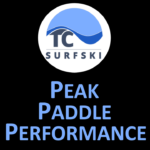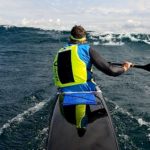Cold Weather Paddling – We Can’t All Live in Maui
As I sit down to write this blog I just returned from paddling in 75 degree water temps in Maui and as I look out on West Bay of Lake Michigan with 2 inches of snow on the ground, it doesn’t look too inviting, and I’m not sure I’ll be motivated to get out there anytime soon. It my finally be time to break out the skis and start getting them waxed up for the season.
The warming trends have definitely led to warmer water temperatures in the Great Lakes over the past few years, but there will always be several months of the year when the water temperatures are cold enough to induce hypothermia in a hurry if you aren’t prepared. The good news is that with the right gear you can get a safe eight month season of paddling and for the die-hards, paddling throughout the entire year is not unrealistic. This year I had an awesome downwind run on Thanksgiving day on West Bay. The wind was blowing from the south at a steady 20 knots, water temps in the 50s and air temps in the low 60s.
Adding to my Cold Water Gear Collection with NRS
Prior to this year, I have never tried to push the paddle season beyond a few paddles in October when we had really nice weather. My typical fall setup involved fleece layering and NRS Hydroskin pants and vest over a polypro or NRS Hydrosilk rashgaurd. For the feet I would layer with fleece socks under neoprene socks/booties and for the hands I always wear NRS Hyrdoskin gloves. (I went through several types of paddling gloves before settling on the hydroskin glove. In additional to providing warmth they offer great blister protection and excellent grip with great dexterity.) This is a decent setup for early fall and I will use it late into the fall if I’m paddling on protected inland water with no wind, but beyond that I feel it is too light to be safe if I were to get into an extended immersion situation.
This year I signed on as an NRS dealer and decided to branch out into more gear options. I purchased a 3 millimeter farmer john wetsuit, a Mission eVent drysuit, and both a short sleeve and long sleeve splash top. I also bought an NRS Mystery Storm Hood (the Sea Hood with Bill is also a great option, both worth their weight in gold and something you should always take with you when venturing out in potentially cold conditions)
First few Experiences in my Drysuit
My first outing in the drysuit I wasn’t sure how to layer and ended up going to heavy with polartec fleece on the top and bottom. I was completely drenched when I finished the six mile paddle and it wasn’t exactly a warm day. The air temps were around the mid 40s. My next time out in the drysuit I tried merino wool on top and bottom and was once again drenched when I finished my paddle. My third outing was probably the best in the dry suit, I went with polypro bib tights and a polypro top along with fleece socks. The air temperature on this day was probably in the mid 30s and it was windy so I also put on the Storm Hood. I was nice and warm the entire paddle but not overly sweaty. My drysuit has latex socks which are nice because if they ever tear they are easy and cheap to replace. The downside is that they don’t breathe at all and can make your feet feel clammy and cold. I read that a really thin layering sock would be best, but found that actually when I wore the fleece socks my feet were the most comfortable.
A “Partial Immersion” Drysuit may be optimal for Surfski Paddling
Prior to buying the dry suit I talked to a lot of surski paddlers who use them religiously for several months out of the year. Most of the guys I talked to agreed that there is just no way to avoid sweating in a heavy duty full immersion suit. I know some surfski paddlers that are opting to go with the “lighter weight” drysuits that typically have a neoprene neck gasket and are considered for “partial immersion” because of the potential for water to leak in at the neck. I also know some guys that cut the latex neck gasket which makes a significant impact in allowing the suit to breathe. Assuming you are wearing a life jacket and won’t have your neck under water this should not significantly compromise your safety.
The dry suit was nice to have on the colder days this fall and if I do any true winter paddling I will definitely use it. I also expect that in the spring when the water temperatures are deadly cold I’ll prefer the drysuit when going out in conditions where I will be more than a 1/2 mile from shore.
Very Pleased with my 3.0 Millimeter Farmer John Wetsuit
For the majority of my fall paddling I was extremely pleased with my NRS 3.0 Farmer John Westuit. My standard setup was to wear polypro bib bike tights (great use for them now that I’m not biking as much) and a long sleeve hydroskin or polartec fleece top, then the wet suit over that and a short sleeve splash top over the wetsuit. Having the splash top over the wetsuit makes a tremendous difference as it blocks the wind and prevents the evaporative cooling that you typically get with neoprene. The splash top is a simple, lightweight, unrestrictive and highly effective piece of gear that should be in every paddler’s arsenal. It is also something that can be easily stuffed into a pouch somewhere when not needed. For my feet I stuck with fleece socks and neoprene booties. For my hands it was the Hydroskin gloves (great grip and dexterity – may be a little light on colder days but in my case my hands always warm up once I get my HR up for a few minutes).
I know that many people will argue wetsuits should be warn directly over the skin, but I’ve had really good luck with a fleece/polypro base layer. My overall setup with fleece base, neoprene over the fleece and then a splash top over the neoprene is exactly the same setup that many of the whitewater guys in Alaska have been running with for over 20 years, so I know it is well proven.
I have the standard NRS 3 millimeter wetsuit, but they also make the “Ultra” version which offers the same weight and flexibility but more warmth through higher tech materials including a titanium laminate that reflects more heat back to your body. I would strongly recommend spending the extra bucks for this one if you can. NRS also makes a Hydroskin Farmer John Suit which is only .5 mm thickness. I haven’t tried this one yet, but I’m certain it would be really nice for late spring and early fall paddling.
The Wetsuit vs Drysuit Debate
There is a lot of debate among cold water boaters as to whether a wet suit or dry suit is most optimal and safe. I’m not sure there is a right or wrong, much of it comes down to personal preference along with the type of boating and water conditions you are in. Paddling in a white water creak is very different than being ½ mile offshore, and being 4 miles offshore is very different than ½ mile offshore. Additionally paddling a sea kayak at 60% of your max heart rate versus a surfski at 90% is very different.
Some people don’t sweat a lot and really like to remain completely dry, for them a dry suit works best. Others don’t mind getting wet and generate enough heat to be very comfortable in a wetsuit arrangement. Wetsuit technologies have come a long way over the past several years and it is now easy to find ones that offer a lot of insulation and warmth while still allowing for good upper body flexibility. Wetsuits also increase flotation and are much easier to swim in than a drysuit. Much of what has been written on-line in the debate between wetsuits and drysuits has been from traditional sea kayak paddlers. They aren’t typically paddling at the intensity level we do in surfskis so I would guess they can get away with much heavier layering under their drysuits.
Surfski paddling is really starting to take off in the Nordic countries where they deal with a lot of cold water. I’ve read a few reports of guys doing some great testing of different gear setups where they are intentionally dumping their boats a mile off shore and swimming to shore to see how long it takes and how cold they are. This is really what it takes to know what works best. I’m anxious to continue following their testing and hear their conclusions.
The Key to Safety in Cold Water
For all paddling excursions, but especially when going out in cold water, the three most important safety factors are having a leg leash that is in good working, a very well-rehearsed and bullet proof remount, and a PFD packed with VHF, cell phone, whistle and flares. With these items taken care of, as long as you dress appropriately to easily handle an immersion and remount and know that you will get warm once you start paddling again, then you should be good to get out and enjoy stretching the season. I haven’t done any true winter paddling yet, but I can say that I’ve really enjoyed the fall and spring paddling seasons.
TC Surfski Will Have NRS Gear This Spring
Starting this spring I will be carrying a full line up of NRS gear, specifically focusing on the items I’ve tested out and have confirmed to work well for surfski paddling. Additionally, I will offer TC Surfski short sleeve splash tops as part of the package for those who sign up for the TC Surfski Immersion Vacation this spring.


